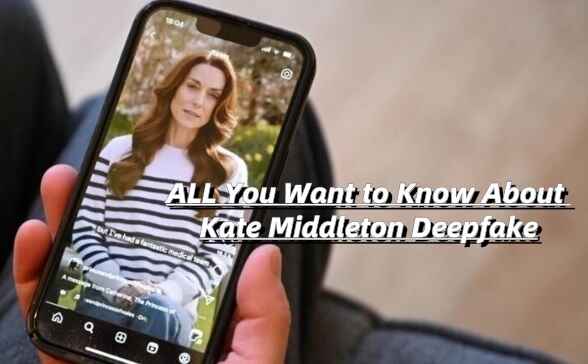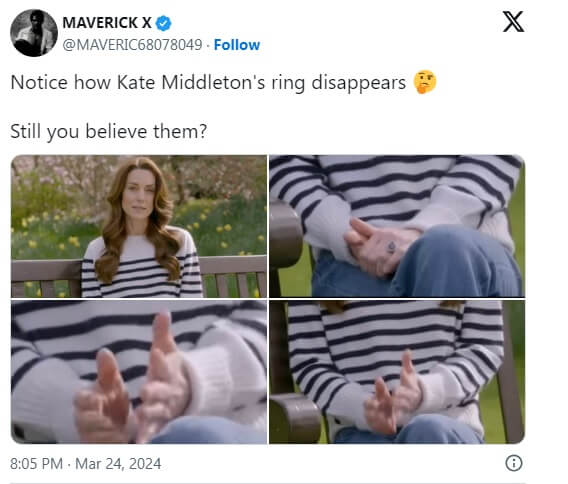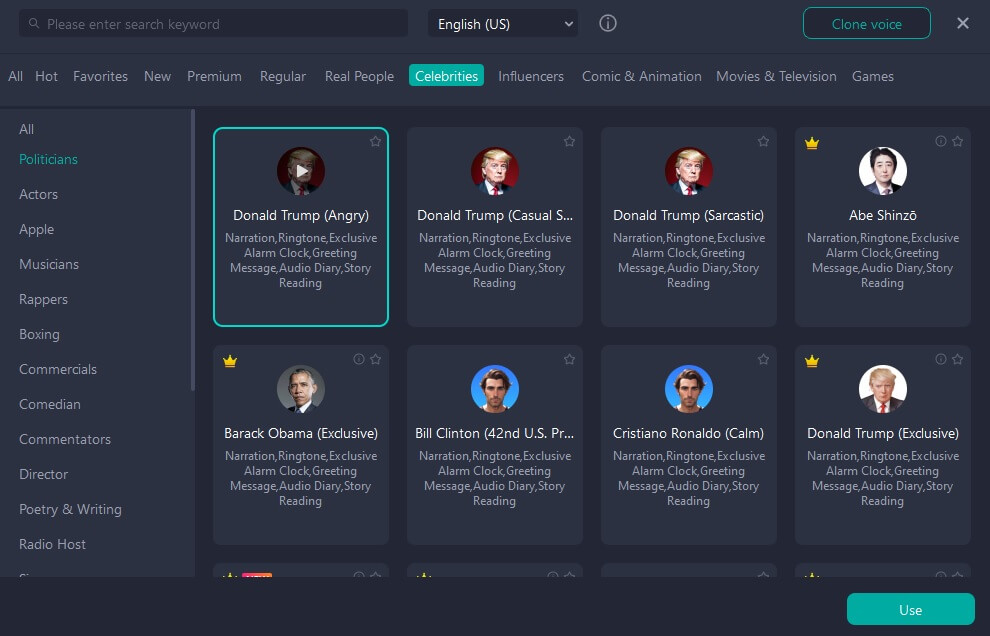The revelation of Princess Catherine of Wales' cancer sparked an immediate backlash against wild social media speculation about her health, with some suggesting she was secretly deceased. Yet, the flood of conspiracy theories persists unabated. Let's delve deeper into the Kate Middleton deepfake incident and discuss how to use AI tools to create Kate Middleton deepfake AI voices.

Part 1: Is the Video of Kate Middleton with Cancer a Deepfake? or AI-Generated?
Part 2: The Risks of AI-Generated Video: Behind the Kate Middleton Deepfakes Incident
Part 1: Is the Video of Kate Middleton with Cancer a Deepfake? or AI-Generated?
First, let's take a look at a controversial Kate Middleton Deepfakes video with cancer.
Kate Middleton's heartfelt video message disclosing her cancer treatment has ignited fresh AI conspiracy theories on social media. Many praised the Duchess of Cambridge for her courage in sharing her challenge of informing her children, Prince George, Princess Charlotte, and Prince Louis, about her diagnosis.
Some individuals, including actress Blake Lively, have apologized for participating in a viral trend that suggested Kate Middleton was "missing" for weeks. Despite being recorded by BBC Studios and not by royal aides, people are claiming that artificial intelligence was utilized to create the extensive video message. For instance, observers noted similarities between the sweater she wore in the video and one she wore in a 2016 video for the mental health campaign Heads Together.
In reality, the video might not necessarily be fabricated. Despite differences in the sweaters, such as shorter sleeves in the charity video, some observers noted that the blue and white top seen in the controversial video resembled another one she wore in November 2023. However, it's unclear why wearing the same sweater twice would automatically imply that the video is fake.
One Twitter user commented that two different AI detection software from separate sources indicated that the video was AI-generated. However, the user's profile revealed them to be an Illuminati whistleblower, which might undermine their credibility.

Additionally, deepware, an AI and deepfake detector, found no evidence of a deepfake in the footage of Kate.
Furthermore, the weather and vegetation in the video matched the reality of February being warm and sunny in southeastern England, with yellow flowers resembling daffodils blooming. Some viewers pointed out a brief disappearance of the ring Kate was wearing, attributing it to motion blur rather than manipulation.
Part 2: The Risks of AI-Generated Video: Behind the Kate Middleton Deepfakes Incident
The proliferation of deepfake technology has sparked concerns about its potential misuse and the implications it holds for individuals, businesses, and governments. The Kate Middleton deepfakes incident serves as a poignant reminder of the dangers associated with AI-generated videos.
Firstly, the spread of deepfake videos can lead to the dissemination of misinformation and the manipulation of public perception. Moreover, the use of AI-generated videos for malicious purposes, such as political propaganda or blackmail, presents serious ethical and security concerns. Deepfake technology has the potential to manipulate public discourse, influence elections, and incite social unrest by fabricating videos of public figures making inflammatory statements or engaging in illicit behavior.

Additionally, the emergence of deepfake videos raises challenges for law enforcement and the legal system. Determining the authenticity of video evidence in criminal investigations becomes increasingly difficult when perpetrators can create convincing fake videos using AI technology. This poses a threat to the integrity of legal proceedings and the administration of justice.
Furthermore, the widespread availability of deepfake technology exacerbates existing privacy issues and risks of identity theft. Individuals may become targets of malicious actors who use AI-generated videos to impersonate them or fabricate compromising content, leading to reputational damage and financial harm.
In light of these risks, there is a pressing need for proactive measures to mitigate the negative impact of AI-generated videos. This includes developing robust detection and verification technologies to identify deepfake videos, implementing regulations to govern the use of AI technology in media production, and raising public awareness about the existence and potential consequences of deepfake content.
Part 3: How to Make Kate Middleton Deepfake AI Voice?
Celebrity AI Voice Generator- VoxMaker is an excellent tool for creating Kate Mideeleton deepfake voices with Text to Speech. It can adjust the tone, intonation, speaking speed by yourself and generate any voice you want.
Additionally, it offers a selection of more than 3200 AI voice models covering over 70 languages. These models encompass a variety of voices, including those of characters, celebrities, singers, and rappers, among others. The platform also features an AI voice cloning capability, allowing users to upload an audio sample and generate a voice that closely resembles it, with a similarity rate of nearly 99%. Users have the option to retain this cloned voice indefinitely and use it to articulate any desired content.


Generate Your Deepfake AI Voice Now!
Key features:
 Extensive AI Voice Model Library: Access a vast collection of over 3200 AI voices in 46 languages, featuring more than 100 different accents.
Extensive AI Voice Model Library: Access a vast collection of over 3200 AI voices in 46 languages, featuring more than 100 different accents.
 Diverse Voice Categories: Explore a wide array of voice categories, including anime characters, famous personalities, singers, and political figures.
Diverse Voice Categories: Explore a wide array of voice categories, including anime characters, famous personalities, singers, and political figures.
 Comprehensive Toolset: Benefit from an all-in-one toolset offering features such as voice cloning, speech-to-text, voice-to-voice conversion, AI-generated rap songs, it also can record, edit, and convert your audio.
Comprehensive Toolset: Benefit from an all-in-one toolset offering features such as voice cloning, speech-to-text, voice-to-voice conversion, AI-generated rap songs, it also can record, edit, and convert your audio.
 Voice Adjustments: Customize voice settings such as pitch, speed, and volume to suit your preferences and specific project needs.
Voice Adjustments: Customize voice settings such as pitch, speed, and volume to suit your preferences and specific project needs.
 Top-Quality Output: Enjoy high-quality export options including MP3, WAV, AAC, and more at no extra cost.
Top-Quality Output: Enjoy high-quality export options including MP3, WAV, AAC, and more at no extra cost.
Part 4: FAQs about Kate Middleton Deepfake
1. How were these deepfake videos created?
Deepfake videos are created using artificial intelligence (AI) technology, which manipulates and superimposes images and audio onto existing footage. In the case of Kate Middleton, AI algorithms were likely used to generate these fake videos.
2. What were the implications of the Kate Middleton Deepfake Incident?
The incident raised concerns about the potential misuse of deepfake technology to spread misinformation and manipulate public perception. It also highlighted the need for increased awareness and scrutiny regarding the authenticity of digital media content.
3. How can deepfake videos be identified?
Detecting deepfake videos can be challenging, but there are various techniques and tools available for identifying them. These include forensic analysis, comparison with authentic sources, and the use of specialized software designed to detect manipulated content.
Conclusion
In this article, we've explored the topic of Kate Middleton's deepfake and the potential risks associated with AI-generated video. Now, you can freely utilize Kate's deepfake AI voice as you wish!
If you're interested in employing Kate Middleton's AI voice for dubbing your content, simply visit VoxMaker . There, you'll discover a diverse range of celebrity voices, including Donald Trump, Joe Biden, Taylor Swift, and many more! With its remarkable ability to produce lifelike AI voices, VoxMaker has become increasingly popular among voiceover enthusiasts, video bloggers, and fans of Kate alike. Try it out for free today!

- Text-to-speech dubbing in 46+ languages & 3200+ voices.
- Transform your words with realistic and expressive AI voice clone.
- Effortlessly fast & secure.

